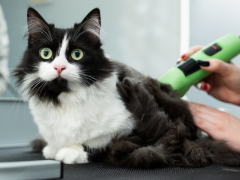
Hookworms are just one type of gastrointestinal parasite (tiny organisms that live in your cat’s gastrointestinal tract, causing adverse health effects). Some other common intestinal parasites seen in cats include roundworms, tapeworms, coccidia, and Giardia. Intestinal parasites are commonly referred to as worms.
Adult hookworms are small parasites (about 1/8th of an inch long) that live in the cat’s intestinal tract in the small intestines where they suck blood from the cat. There are three species of hookworms that infect cats: Ancylostoma tubaeforme, Ancylostoma braziliense, and Uncinaria stenocephala (which is rare in cats in the United States).
Quick Overview: Hookworms in Cats
 Other Names: Ancylostomiasis in cats
Other Names: Ancylostomiasis in cats
 Common Symptoms: Dark black tarry stools, weight loss, diarrhea, lesions in between the toes on the feet, pale gums, weakness.
Common Symptoms: Dark black tarry stools, weight loss, diarrhea, lesions in between the toes on the feet, pale gums, weakness.
 Diagnosis: Hookworm eggs are typically detected microscopically in fecal/stool samples.
Diagnosis: Hookworm eggs are typically detected microscopically in fecal/stool samples.
 Requires Ongoing Medication: No
Requires Ongoing Medication: No
 Vaccine Available: No
Vaccine Available: No
 Treatment Options: For simple cases, certain deworming medications will kill hookworms. Because hookworms can cause severe blood loss if untreated, iron and other nutritional supplements may be needed, especially for young cats or kittens. Severely anemic cats may need a blood transfusion and hospital care.
Treatment Options: For simple cases, certain deworming medications will kill hookworms. Because hookworms can cause severe blood loss if untreated, iron and other nutritional supplements may be needed, especially for young cats or kittens. Severely anemic cats may need a blood transfusion and hospital care.
 Home Remedies: None
Home Remedies: None
What Do Hookworms Do in Your Cat’s Body?
Once attached, hookworms release an anticoagulant (a substance that prevents blood clotting) and feed on your cat’s blood. They may detach from the spot in the intestinal wall and reattach in another spot, leaving behind small bleeding ulcers where they were last attached.
In the intestine, adult female hookworms shed eggs, which are then deposited into the environment through the feces. Once outside of the cat, the eggs go through several stages, hatching and developing into larvae (called third-stage larvae).
The life cycle of a hookworm is dependent upon a host. Hookworm larvae cannot develop any further on the outside—the larvae must enter a host (your cat) to develop into adult hookworms. However, infective larvae can live in soil for a few months under ideal conditions.
How Do Cats Get Hookworms?

Cats get hookworms when they ingest hookworm larvae, typically when walking on a contaminated surface. Cats may pick up hookworms through their skin or during grooming.
Cats can become infected when they ingest the hookworm larvae. This might occur if the cat walks on a surface in a contaminated environment and gets hookworm larvae on the skin or fur, then swallows the larvae during self-grooming.
But cats don’t have to ingest the larvae to become infected. Simply walking across surfaces contaminated with feces (whether a litter box, contaminated soil, or another surface) can cause infection because hookworm larvae can penetrate the skin.
All cats can become infected with hookworms, but the cats at the highest risk are those that go outdoors, are housed in close quarters with large numbers or other cats (like in animal shelters or breeding catteries), or are kept in areas with poor sanitation. Kittens can become infected during nursing through their mother’s milk if the mom cat has hookworms.
Hookworms are zoonotic, which means they can be transmitted to people. Dogs can also get hookworms.
Hookworms in Cats Symptoms
Severe hookworm infestations with large numbers of adult worms (especially of the species Ancylostoma tubaeforme) can cause anemia, diarrhea, and weight loss, especially in kittens. Such infestations are potentially fatal.
You might not see any signs of hookworms if your cat is infected with a small number of worms.
Larger infestations and hookworm infections in very young kittens may have one or more of the following common clinical signs of hookworms in cats:
- Lesions on the bottoms of the paws and in between the toes
- Dark, black, tarry-looking stool
- Diarrhea
- Constipation
- Pale gums
- Weakness
- Weight loss (or failure to gain weight in growing kittens)
Some cats infected with hookworms may display coughing. This is because the hookworm larvae first migrate to the lungs on their way to their eventual destination (the intestines).
Hookworms in Cats Treatment

Once your vet has identified the hookworm infestation, treatment with an appropriate dewormer is recommended.
The only way to know for sure that your cat has hookworms is through a fecal floatation test. Your veterinarian will take a sample of your cat’s stool and examine it under a microscope to look for the presence of hookworm eggs.
The Companion Animal Parasite Council recommends that adult cats be routinely tested for intestinal parasites at least twice a year; kittens should be tested four times during their first year of life.
Once your veterinarian confirms the presence of hookworm eggs in your cat’s stool, you can administer a deworming medication that will kill the adult hookworms. After the initial dewormer dose, a second dose is given about 2 to 4 weeks later to kill adult hookworms that developed since the first dose.
Also Read: How To Deworm A Cat
You can obtain deworming medication from your veterinarian or buy over-the-counter hookworm medicine for cats (available without a prescription) online. If you choose to purchase a non-prescription dewormer, ask your veterinarian for recommendations on which product to choose.

Adult hookworms attach themselves to the intestinal wall from their mouths using their curved teeth, which resemble hooks—hence the common name.
Although natural remedies for hookworms in cats are also sold over the counter, these may not work as well as a traditional dewormer.
Deworming medications for cats are safe and effective when used correctly. Always consult your veterinarian for advice before giving any dewormer to your cat, whether prescription or over-the-counter.
Cats or kittens that are anemic, dehydrated, or malnourished from a hookworm infection may require additional treatments, including blood transfusions, fluid therapy, and nutritional support.
To prevent hookworm infection, as well as infection with other intestinal parasites like roundworms, veterinarians and the CAPC recommend using year-round broad-spectrum parasite preventives.
Certain flea, tick, and heartworm preventives designed to be given monthly also protect against certain intestinal parasites like hookworms and roundworms. Always use products labeled for use in cats (never use dog products on a cat), and talk to your veterinarian about the best parasite prevention for your cat.
Another prevention method is to promptly pick up and discard feces in your cat’s environment. Place the feces in a plastic bag before throwing them away in the trash. Wear gloves when handling the feces to protect yourself from potential hookworm larvae.
Are hookworms in cats contagious?
Yes. An infected cat will pass hookworm eggs through their poop, where the eggs will then mature into larvae. If another pet in the house eats the infected poop or steps in the poop and then licks their paws, they can become infected.
Hookworms can also infect people. This typically occurs if someone is walking barefoot in soil or sand where an infected cat has pooped. The hookworm larvae burrow into the skin and then migrate under the skin until they die several weeks later. The larvae do not mature into adults.
People with hookworms experience itching and pain during larval migration and the immune reaction when the larvae die. This condition is often called cutaneous larval migrans to describe the larval migration in the skin.
It is unlikely that you will be walking barefoot near your cat’s poop in your home, so chances are low that you will get hookworms from your cat.
Frequently Asked Questions
Are hookworms in cats contagious to humans?
Yes, people can get hookworms from cats. Hookworms are zoonotic, which means they can pass from animal to human. Humans typically become infected by walking over infected soil or another contaminated surface. However, when humans become infected with cat hookworms, they usually develop a skin infection called cutaneous larva migrans, rather than diarrhea and other gastrointestinal signs.
Are hookworms in cats contagious to dogs?
Yes, dogs can pick up hookworms from cats, especially dogs living in the same home as an infected cat. This is why it’s important to keep both your cats and your dogs on year-round broad-spectrum parasite control. Some monthly flea and heartworm preventives also protect against intestinal parasites like hookworms.
Can you see hookworms in cat poop?
No, adult hookworms remain in the cat’s body. Hookworm eggs are passed in the stool, but the eggs are microscopic and cannot be seen with the naked eye.
Can cats throw up hookworms?
No. However, cats may throw up roundworms or tapeworms.








In the form of question and answer to introduce, very detailed, very good popular science articles